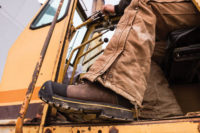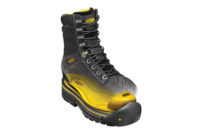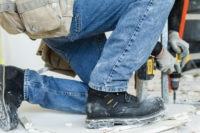From indoor manufacturing to industrial athletes, hard work requires gear that works harder. Safety footwear is an important part of a working person’s tool kit, especially when faced with long days on their feet and challenging environments on the job site.
Just as a structure needs the right foundation, workers with a good working knowledge of the construction, safety and performance features of their safety footwear will be better prepared to reduce foot fatigue, improve performance and be protected from step one.
When choosing a safety boot, here are some things to consider:
1 Tread design
Choosing the correct tread design of the outsole is important for workers dealing with conditions where footing can be uneasy at best.
Finding footwear with a lugged perimeter and tighter, smaller tread design from heel strike through forefoot helps alleviate slips on wet or oily surfaces. It displaces liquid quickly to guarantee the fastest and most surface area contact for sure footing. Footwear like this works well in slick or wet environments as well as indoor manufacturing.
For workers walking on a job site with lots of debris and potential for mud, the tread design should be further apart and more lugged to grip into the ground, and displace it as quickly as possible, but also to self-clean so with each step taken you are assured it will be stable and secure, and safe.
2 Construction
Safety footwear should never be chosen on aesthetics alone. Understanding how a boot is constructed helps the wearer better understand how it will perform.
Goodyear Welt: A Goodyear welt construction is often the best selection if the terrain and surface area being walked on/worked on is rocky and uneven. This construction style offers torsion control to ensure the foot will not flex over rocks and fatigue the legs or lower back. Those working in industries including railroad and construction and in environments with gravel and rock benefit from this type of construction. Advantages to welted construction include superior durability and torsion control along with the ability to be re-soled in the future. Disadvantages include often being more expensive as well as increased stiffness for the wearer.
Direct Attach: Direct attach construction offers some torsion control, but is not as heavy and stiff as the Goodyear welt. Its optimal work environment is medium gravel, some uneven work areas, but most general work areas. Benefits include good torsion control, lighter weight than a welted product and a direct bond for a seamless construction without glues or cements. Disadvantages include less flexibility and a higher price point than a cemented product.
Cement: Cement style construction offers the lightest weight of all three, and it is also the most flexible. Its benefit is offering optimal comfort and cushioning. Also, depending on the overall construction, it offers the ability to feel the ground or work surface area beneath the foot. This can be important for professions like roofing where it is ideal to feel where the foot is placed and be surefooted. Other industries where cement constructed footwear is ideal includes indoor manufacturing and construction. Benefits to cement construction include extreme lightweight flexibility at a lower price point. Disadvantages including extreme foot/leg fatigue if used on uneven surfaces as well as the chance of delaminating over the life of the boot.
3 Protection
Protective toe caps are commonly required on the job site to protect from crush and impact injuries. Safety toes are typically made of one of three materials: aluminum, composite and steel. All three must satisfy the same ASTM requirements. Each material offers different benefits. Aluminum offers the lightest weight option. Composite toes are non-metallic and lighter than steel and non-conductive to heat and cold and are good choices especially when workers require non-metallic footwear or in extreme temperature environments. Steel toes, the most common safety toe-cap, are typically the lowest cost option. It’s important for workers to remember if they suffer a foot impact on the job site, even if it doesn’t result in an injury, they must replace their safety boot. While steel toes may dent on impact, a composite toe, for example, might be cracked, compromising its ability to protect the foot from a future crush or impact.
4 It’s electric
Boots with an EH outsole distinction provide electrical hazard protection against accidental contact with an electrical current. Static dissipative footwear with an ESD classification helps prevent buildup of excess static electricity. This is essential for workers where a spark could be dangerous, such as environments with gas or caustic chemicals or indoor environments with electronics, computer chips or other sensitive technologies.
5 Fit matters
Finding the right fit is important when choosing a work boot. All the protection and quality of construction do little to help a worker suffering from the pain of too small boots that pinch the feet. Feet tend to swell throughout the day, especially for those on their feet. Shopping for work boots in the afternoon or evening will provide a better sense for how your boots will fit and feel after a long day of work. If the boots are too tight, it may lead to a variety of foot ailments including in-grown toenails, blisters, or corns. Don’t be afraid to move up a half-size or adjust the type of socks you are wearing.
When it comes to socks, invest in a well-made pair constructed with wool or a wool blend to help provide natural odor and climate control.
At my company we like to think of boots as tools for your feet. Choosing the right tool for the job starts with understanding your options. Prior to shopping it’s also important for you to understand what the job requirements are, something a safety manager or foreman should be able to tell you. With a little research you’ll be ready to stand up to the hardest days of work with footwear that stands with you.



